Remember the old BASF commercials? “We don’t make a lot of the products you buy. We make a lot of the products you buy better.” It’s a trademarked phrase, of course, but it captures the way Craig Powell sees Haivision. “You don’t know us but we are in everything you do,” he says.
Powell is the executive director of global ISR business development for the Montreal company, which has customers worldwide. But he usually has to begin conversations in Canada by explaining what they do.
If you provide or operate an ISR platform – air, land or sea – chances are it has a small Haivision box embedded in it. “We’re the glue of ISR,” he says. “Cameras can be cameras on their own, radios can be radios on their own, mission systems can be mission systems on their own. You have to have that [box] to bring it all together.”
When President Obama and his national security team watched the operation to capture of Osama bin Laden, the encoded video was streamed through a Haivision product. (It is also the encoder for all video streaming into NFL headquarters on any given Sunday afternoon.) So it’s not surprising that its largest customer is U.S. Special Operations Command.
In a nutshell, Haivision’s products encode and decode video data, compressing it from gigabytes down to megabytes per second for transmission.
“A FLIR Star SAFIRE high definition camera, for example, is generating 1.5 gigabytes per second. It’s also streaming out metadata: heading, direction, altitude, line of sight. That comes out of the camera, hits our box, we compress it down to a tiny pipeline and at the same time we multiplex that metadata, synchronized to each frame. When it…hits the decoder in a mission management system, the decoder grabs the metadata and populates the map and grabs the video and displays it on the screen,” Powell said.
Though the company has garnered a reputation with special forces – CANSOFCOM is also a customer – and it has sold into ships and manned and unmanned aircraft, Haivision is setting its sights on land vehicles. “The LAV UP has a requirement to take the gunners and commanders video and format it into an IP stream that can be either moved [within the LAV]…or back to a commander,” said Powell, who served 13 years with the Canadian Army.
As to why the company isn’t better known in Canada, despite its presence in so many systems, Powell says the ISR environment is just starting catch up with the U.S. “As a military, we are growing that piece and Haivision is trying to grow with it.”
